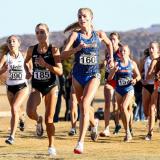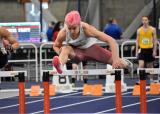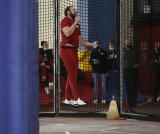Folders |
Camel City Elite Q&A With JDL Fast Track's Craig LonghurstPublished by
Exploring Camel City’s Founding And Development As Elite Meet Returns This Weekend By Hannah Borenstein for DyeStat Not far off Highway 40, past Foothills Brewing, on the end of a dead end street in Winston-Salem, North Carolina, lies an unassuming warehouse. Formerly occupied by Jostens – a yearbook publishing company – and filled with publishing materials, now the green-and beige-laned JDL indoor flat track occupies the space, and it has boasted some of the most exciting races in the country over the course of the past decade. Unlike venues in New York, Boston and Seattle, which host some of the best indoor competitions on U.S. soil, Winston-Salem is not typically thought of as an urban hub well positioned to lure in Olympic medalists, national record holders, and rising stars in track and field. However, Camel City, nicknamed to pay homage to its tobacco history (one fraught from histories of slave labor), has indeed drawn some of the best athletes and the 2022 Camel City Elite Invitational meet this weekend promises to continue that tradition. CAMEL CITY ELITE INVITATIONAL WEBCAST INFO On the 10th anniversary of Camel City Elite, which will bring eight Olympians to Central North Carolina, I sat down with meet founder and director Craig Longhurst to talk about the history of the facility, the meet, and its legacy. Question: I’m wondering if you can just start by taking me through the history of how the meet was started? Longhurst: I work for my father-in-law and he owns JDL Castle, which is a real estate development firm. About 11 years ago he came in the office and said, “I’m tired of running in the winter outside. Let’s find a warehouse and build an indoor track.” That same year, the only indoor track in North Carolina was in Chapel Hill and it was closed for renovations, which usually hosted the North Carolina state championships. They could have either moved all the equipment around on UNC’s campus or moved it to another state, but how could you have a North Carolina state meet in Virginia? So they held the indoor state meet as a polar bear that year. That happened around the same time we were building the track and Clemson was reducing its capacity so we started to think there might be a place for us to hold meets. We didn’t know what we were really doing and it was never intended to make money. And it still does not make money. It loses money every year because we only have three-and-a-half months to have events and we still have to maintain it the rest of the year. But we found this building, renovated it, and went from hosting five meets the first year, to 27 the second year, then we jumped to 36, and have been between 40-50 meets each year ever since. At first, Power 5 schools weren’t interested, but in 2012, they came out with the flat-track conversions. The new conversions had a formula, which changed mile times over one second, which can make a big difference in getting into NCAAs. And the DMR (conversion) is even greater. So despite the fact that Camel City Elite gets so much attention because of the pros, I have a few teams coming from as far as Washington state to run here. Question: So how did the first Camel City Elite come to be? Longhurst: Well when the new conversions came out, we thought maybe we could do something to get some pros involved and put collegians in the race with the pros and let the pros duke it out up front and just pull the college kids along. And it did work a little bit. That first year Ford Palmer had already run about 4:02 and he ran 4:05, so his conversion was within tenths of a second. There was one year Elly Henes ran 9:06 here and it converted to 9:02 and then the next week she went to Iowa State (with a banked, 200-meter track) and ran 9:02. I need to create a document with these conversions because I do think the conversions are fair. Of course it’s in my interest to say so, but based on what I’ve seen, I do think they are fair. Question: The pros don’t really need to be focused on the conversions, so how did you go about getting them to come down here? Of course there’s prize money, but where does that come from, and how do you make the decisions to shell it out? Longhurst: The first year it just came out of my father-in-law’s pocket and I don’t even remember how we really got to some of those guys. Matt Elliott and Corey Leslie were kind of local, so that helped. But we paid them in cash. He won $2,000 and I remember David handed him 20 $100 bills in an envelope, and he was shocked that he was getting paid so quickly. At one meet Leo Manzano got his check right away and told me, “I’m still chasing down money from a Diamond League meet in July.” So I think that paying athletes promptly went a long way to giving us some legitimacy in what we do. Then we started adding a crowd-funded dinner and corporate sponsors. But we knew we’d need a big name so we targeted Nick Symmonds a few years later to race. So after Nick got the silver at Worlds, right after he signed with Brooks. We were able to get him and increase the prize money, which helped establish Camel City as a big meet. Question: How do you take into consideration other major meets happening in the winter (i.e., Millrose and New Balance), and how do you still manage to attract the top talent? Longhurst: Well I go off the NCAA schedule. I know Millrose and New Balance are somewhat beholden to World Athletics to tell them when their meet is. So there’s no really good answer, but I wish World Athletics had a set schedule because NCAA is the same weekend every year. Millrose is always changing, and if World Athletics could make it the same weekend we could work around that and help to develop something of an East Coast tour, that would help. Question: You said you’re not really making money, so what are the plans moving forward? Longhurst: I’d like to make a bit more headway with the NCAA and become something like a Husky Classic with more sections. So even to have more tiers not just for those to qualify for nationals but also to provide opportunities for those trying to get into meets like ACCs. Question: Now that you’ve been in the game a while, have your ideas developed about how to finance good indoor track meets, especially when it comes to streaming and broadcasting? Longhurst: We’ve looked into broadcasting on TV but all the production costs would be on us, and we’d be looking at between $100,000-$200,000. So our relationship with RunnerSpace has been great in that regard. I know some people complain about all of the track subscriptions, but they don’t mind having Netflix, HBO, and all of those other streaming services. I love that CITIUS was able to stream some meets for free last year, but we like working with RunnerSpace because all of the heats of every event are recorded, so then parents of every kid that race can go back and watch those races. Question: Yeah, I know there are some people that thing everything should be free, especially the younger folks that are able to watch other sports on television. Of course, I’m not sure they realize that someone is paying a cable bill. I think the problem in track and field is not that there are subscriptions, but there seem to be so many different ones. Longhurst: Yeah, definitely. Some of those meets, like Payton Jordan, on the west coast, too, are so late for east coast fans. Am I really going to stay up until 1 a.m.? At least something like the NBA sets up the time schedule to accommodate the three time zones. So things are also at odd times. I’m not sure what the best options are right now, but at least other sports on major television have their game times set up to allow everyone to watch. So that might be something we need to consider moving forward. More news |




